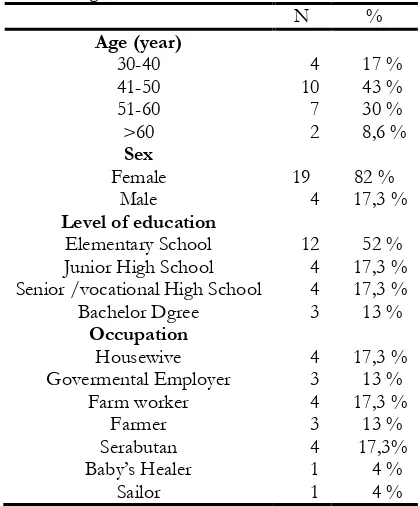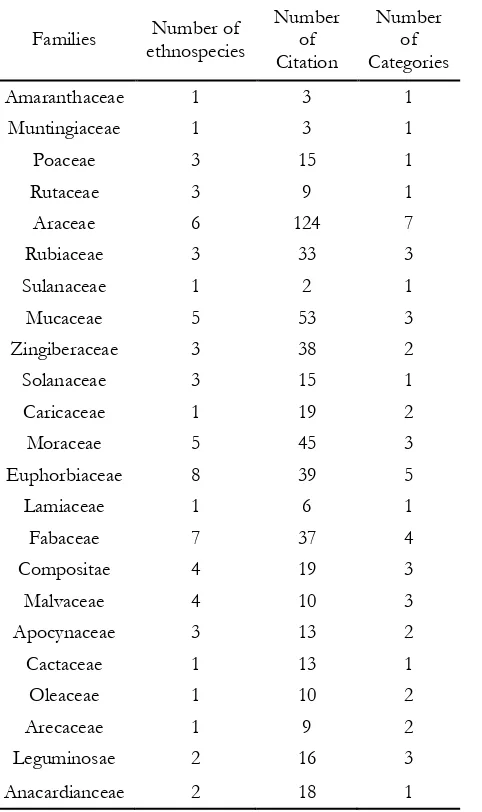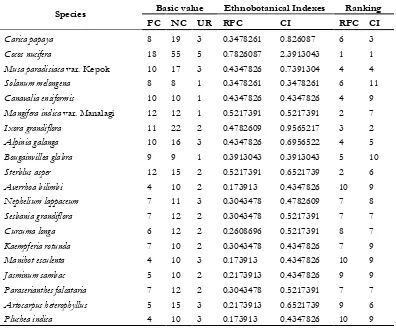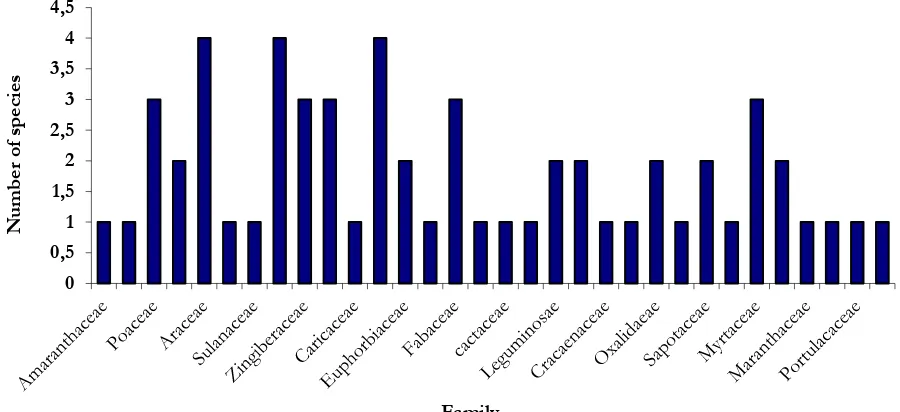VOL. 3, NO. 2, pp. 96 – 103, May, 2013
Ethnobotanical Investigation to Conserve Home Gardens’s Species of
Plants in Tambakrejo, Sumbermanjing Wetan, Southern of Malang
Ratih Nila Pamungkas*, Luchman Hakim
Biology Departement, Faculty of Mathematics and Natural Sciences, Brawijaya University, Malang, Indonesia
ABSTRACT
In developing countries, traditional knowledge of indigenous people is being widely threatened by current trends of economic globalization especially in tourism destination area such as in Tambakrejo village, Sumbermanjing Wetan, Malang. This region covers Sempu Island as well as the proposed pro tected area. The aims of the investigation are to find outthe diversity of species of plants that made up -home garden species, to measure the use value of each species of plants using ethnobotany indexes, and to describe methods of preparation and uses of the important plants. The study represents the first step to documenting significant utilization of the species of plantsin home gardens based on indige -nous knowledge before it disappears. Data was collected through depth and semi structured inter-views. Informationgathered was about traditional uses of wild plants as well as cultivated plants. All the collected data was filled into an analytical table and,for the ease of analyses, was grouped into ten categories continued with detailed information on uses. Data was calculated using synthetic indexes, namely Relative Frequency of Citation (RFC) and Cultural Importance Index (CI). One hundred and one plants were cited by informants as being traditionally used in the area. These 99 ethnospecies belong to 45 families. From the 10 categories, most of them are used for allimnetary, medical, and eco -nomical plants. For allimentary plants, 316 citations, 58 species, and 5 different uses were recorded. For medical plants, there were 63 citations, 22 species, and 4 different uses of categories. A few species of plantsbelong to others categories, like erotion control. The study shows that traditional uses of plants especially at home gardens still survives as part of cultural heritage of the community, for some economical reasons, and also for daily activities.
Keywords: ethnobotanical, home garden, traditional knowledge
INTRODUCTION
The investigation on ethnobotanical study based on indigenous knowledge has brought much contribution for ecologists, pharmacolo-gists, taxonomists, and also environmental mana-gers to protect their field of work, especially the ones related with high quality biodiversity areas. For example, in the field of pharmacology, plant-based traditional knowledge has become a recog-nized tool in search of new sources of drugs and neutraceuticals [1, 2]; the knowledge is also im-portant for maintaining germplasm in a con-served area. Knowledge on the utilization and traditional food processing techniques as well as
*
Corresponding address: Ratih Nila Pamungkas
Biology Department, Faculty of Mathematics and Natural Sciences, Brawijaya University, Jalan Veteran, Malang, Indonesia 65145
E-mail: ratih_nilapamungkas@yahoo.com
types of germplasm maintained by farmers are a prerequisite for investigating ways to improve the germplasm maintenance of food crop [3].
globa-lization that promote intensive agriculture, in-dustrialization, and the migration of rural popu-lation to urban areas [5]. Those cases also appear in Sumbermanjing Wetan, Malang, especially in tourism destination area such as Tambakrejo village. This region includes Sempu Island as well as the proposed protected area. Most of the yo-ung females are more interestedin being a TKW (female workers) in other countries than in deve-loping their own region. Thus, it is worry some that tradisional cultural heritage and a lot of local uses of plants are not mantained as well as be-fore. The aims of the investigation were to find out the diversity of species of plants that made up home gardens species, to measure the use value of each species of plants using ethnobo-tany indexes, and also to describe methods of preparation and use of the significant plants. The study represents the first step to documenting significant utilization of the species of plants in home gardens based on indigenous knowledge before it disappears.
MATERIALS AND METHODS
Description of the study area
Tambakrejo village is located south to Malang region. It covers 2735.830 ha of land, consisting of Tamban district and Sendang Biru area. This region includes Sempu Island as well as the pro-posed protected area (Figure 1). The population of the area is around 6,890 people. In average, there are 255 families live in Tamban district and the others live in Sendang Biru. Until 2011, the livelihood of people in Tambakrejo are in agri-culture, fishery, cattle breeding, tailor, carpenter, and seller. The landscape includes forest, hills, and beaches, with altitude of 0-100 m, and ave-rage temperature of 26 °C-30 °C. Based on the data from a survey in 2010 by Malang govern-ment, Tambakrejo village has 123 ha area used as
home gardens and 511 ha used as settlement. Most of Tambakrejo villagers are Javanese and just some of them are Maduranese. There are some traditional rituals that usually take place there, such as larung sesaji and petik laut tradition, traditional wedding ceremony, pregnance cere-mony, baby delivery cerecere-mony, death cerecere-mony, and also bersih desa. Beside those rituals, the culture of bertegur sapa and rembug desa are still done by the people of Tambakrejo village [6].
Sampling procedure
The investigation was caried out from Sep-tember 2012 to Januari 2013. Information was collected on traditional uses of species of plants in each of home gardens, both wild plants and cultivated plants. Only 23 informants from 23 home gardens areas were selected and involved in the study. The requirement of the informants were people who were born and had always lived in the area. In addition, we also made sure that the source of their knowledge about local uses of plants had come only from their traditional cul-ture.
Local society refers to people who live and stay in a region for a long periode, who can maintain their community that is different from other communities, especially the modern people [7]. Similar questions were given to each infor-mant as to get compilation of indigenous know-ledge. Information was collected through deep interviews in their local language (Javanese la-nguage) and Indonesian. Specimens of the cited species of plants were prepared as herbarium and deposited in LIPI Botanical Garden, Purwodadi, Pasuruan, for identification. Systematic arrange-ment and nomenclature were made based on Flora of Java and Botanical Garden Catalogue. Deep interviews were done to get short descrip-tion on how the local people used those plants.
Data analysis
Data was collected and arranged in analysis table employing Microsoft Excel 2007. Data was classified into ten general categories, those were: alliment, medicine, animal food, firewood, cons-truction, cultural ceremony/ritual, craft and tech-nology, economy, ornament, and others. The ca-tegory of alliment included human food and beverage, as well as cooking spices. Plants be-longing to ritual category were the ones used in religious events, larung sesaji ceremony, wedding ceremony, etc. Craft category included plants used for making handycraft, rope and others ob-jects. Finally, the last category, others, included species for nginang, hedges, and aromateraphy.
Quantitative analysis of the data was done to pects were known. The ethnobotanical indices are found on the basic structure of the ethno-botanical information; those are informants men-tioning the categories of uses [8]. Data analyses were followed by ethnobotanical indexes. The data analyses were:
Relative frequency of citation (RFC) is used to find out probability between number of peo-ple who giving citation to each species and num-ber of all informants. The result is describe local importance of each species. RFC was calculated by Formula (1)[9].
... (1)
Note: NF: number of informant who gave citation at each species
N :total of informant (in this studi 23 informant)
Cultural Important Index (CI) can be used to compare the plant knowledge among different cultures [10], this also can be used to know di-versity information within each species if colabo-rated with diversity indexes [5]. CI was calculated by Formula (2)[9]:
... (2)
Note: NC: total number of different categories of uses UR: total number of use reports for each species total
N: number of informant (23 in this study)
These are much more detailed and numerous than most of plant resources, especially alimentary and medicinal plants, are managed by women [11]. The informants were mostly elderly people and had worked in the region for many years. Most of the informants (43 %) were at the age of 41 until 50 years old. The reason to choose peo-ple above 30 years of age was based on conside-ration that people above 30 had larger know-healers, retired people and others.
Table 1. Basic information of informant in Tambakrejo village
Senior /vocational High School 4 17,3 %
Table 2. Ethnobotanical plants
is usually cultivated with heterogeneous species of plants [13].
Based on botanical identification of the spe-cimens, these 99 ethnospecies belong to 101 taxa and 46 families. Each of the taxa was identified directly by the informants while the observation was being done. There were three kinds of spe-cies with the same local name as petetan, although those are actually different species. There is usu-ally a difference between local names and botani-cal names of species, in which a single ethno-species may sometimes be identified as more than one botanical species, and although some-times the species may belong to different fami-lies [14]. The family having the highest number of ethnospecies was Euphorbiaceae (Table 2), followed by Fabaceae (7 members) and Araceae (6 members). The families mostly mentioned were Rubiaceae with seven different categories of uses, followed by Mucaceae with three rent categories, and Moraceae with three diffe-rent categories.
Local importance and cultural importance of species plants in Tambakrejo home garden
Based on the quantitative analysis for each species of plants found in Tambakrejo home gardens (Table 3), we can find out local and cul-tural importance of each species. Cocos nucifera
Table 3. Result of analysis used by RFC and CI indexes for most relevant species
Species Basic value Ethnobotanical Indexes Ranking
FC NC UR RFC CI RFC CI
Carica papaya 8 19 3 0.3478261 0.826087 6 3
Cocos nucifera 18 55 5 0.7826087 2.3913043 1 1
Musa paradisiaca var. Kepok 10 17 3 0.4347826 0.7391304 4 4
Solanum melongena 8 8 1 0.3478261 0.3478261 6 11
Canavalia ensiformis 10 10 1 0.4347826 0.4347826 4 9
Mangifera indica var. Manalagi 12 12 1 0.5217391 0.5217391 2 7
Ixora grandiflora 11 22 2 0.4782609 0.9565217 3 2
Alpinia galanga 10 16 3 0.4347826 0.6956522 4 5
Bougainvillea glabra 9 9 1 0.3913043 0.3913043 5 10
Sterblus asper 12 15 2 0.5217391 0.6521739 2 6
Averrhoa bilimbi 4 10 2 0.173913 0.4347826 10 9
Nephelium lappaceum 7 11 3 0.3043478 0.4782609 7 8
Sesbania grandiflora 7 12 2 0.3043478 0.5217391 7 7
Curcuma longa 6 12 2 0.2608696 0.5217391 8 7
Kaempferia rotunda 7 10 2 0.3043478 0.4347826 7 9
Manihot esculenta 4 10 3 0.173913 0.4347826 10 9
Jasminum sambac 5 10 2 0.2173913 0.4347826 9 9
Paraserianthes falcataria 7 12 2 0.3043478 0.5217391 7 7
Artocarpus heterophyllus 5 15 3 0.2173913 0.6521739 9 6
Pluchea indica 4 10 3 0.173913 0.4347826 10 9
the informants. The CI value of Ixora grandiflora
was higher than M. indica although 12 people or 52 % of the informants cited M. indica. This was caused by the fact that M. indica was only used for alliment, which was for fresh fruit con-sumption.
In addition, Alpinia galanga or laos also had a high value of Cultural Importance, after Musa paradisiaca. Local people in this area mostly used
laos as a cooking spice, since the special product of this region was sea food. Averrhoa bilimbi or
belimbing wuluh also played an important role in the processing of sea food, especially to vanish thebad odor of fish. A. bilimbi fruit was also used to make syrup and its flower could be used to treat cough. From those examples above, we know that the low citation of species of plants by informants does not mean that species were less interesting and useful. The CI index is an efficient tool for high lighting those species with high cultural agreement for the whole survey area and for recognizing the shared knowledge of these people [9].
Plant Used Based on Indigenous Knowledge
Indigenous knowledge (IK) is one of unique experiences applied to traditional knowledge that
is transferred to younger generationand is still developed by rural indigenous communities in specific geographical areas. The characteristics of IK appear and are developed in specific society; they are unique and exclusive [16].
In Tambakrejo village, 59 species of plants were documented as traditional alliment belong-ing to 33 families (Figure 2) and wide spread in all home gardens. This indicates the diversity of traditional alliment in Tambakrejo village. The highest species were Araceae, Mucaceae and Moraceae,each of which had 4 members, follo-wed by Zingiberaceae with 3 members. Araceae included Colocasia giganteum, all members of C. nucifera, and Arenga pinnata. Mucaceae included all members of M. paradisiaca. Moraceae included
Artocarpus genus (A. camansi, A. heterophyllus, A. elasticus, and A. altilis). Members of Zingiberaceae mostly were used as cooking spices, such us C. longa, K. rotunda, A. galanga.
Figure 2. Plants families most commonly used for traditional alliment by indigenous people in Tambakrejo village
santan from the old ones. The next mostly men-tioned species was papaya (C. papaya); most of the local people plant papaya trees in their home gardens, they usually cook the young fruit, papa-ya flowers, and leaves as vegetable, and use the ripe fruit as fresh fruit, cocktail, and salad. Buah naga or dragon fruit (Hylocereus polyrizus) was cited by 13 informants, and all of them used the fruit as syrup and ate it as fresh fruit. Next was M. indica which was used as fresh fruit or salad. There was also one kind of species of plants that was usually used to strengthen the flavor of
Tambakrejo villagers used Senna siamea for firewood and construction. Fresh young leaves and fresh young flower of S. siamea have been used as vegetables in Thailand by boiling them in water for half an hour and then the boiled water is discarded. The marc is reboiled for another 1-2 times as before and the boiled leaves are then mixed with coconut milk and curry paste and cooked as a curry. The meal is recomended to be consumed as a healthy food to be a mild laxative and sleeping aid [17].
There were 22 ethnospecies found as traditio-nal medicitraditio-nal plants (see Table 4). Plants used for treatment for more than 10 different medi-cinal conditions were grouped into several cate-gories according to uses by indigenous people.
Those categories were gastro intestinal disorders, dermatological contiditions, ilness associated with pain and/or fever, women medicine plants, eye remedies, and other uses.
Table 4. Categories of use plant species home garden at
Seven informants cited that C. nucifera or degan ijo was used for detoxicant, especially to treat food or beverage alergy. Detoxicant or depurant means that the plants can help the recovery pro-cess from different diseases since the plants are able to purify the blood and remove toxins and scum, and are possible to stimulate diuresis [18].
Six informants cited that C. longa or turmeric couldbe used for gastrointestinal disorder, wo-man medicine, and also fever. The inforwo-mants said that a potion, with or without honey, might be prepared as medicine. Importantly, turmeric can also be mixed with chicken food to reduce the bad smell of the feces. The leaves, stems, roots and flowers of C. papaya are effective to treat malaria. The leaves of papaya are made as decoc-tion. Other species were recorded to treat
sto-machache, and diarrhoea. Treatment for diar-rhoea is done using the leaves of Psidium guajava, drank as decoction. Circular massage is done with the leaves of Jatropa curcas to treat flatulence that causes stomachache. Decoction from the bark of Artocarpus altilis and Morinda citrifolia is also used in Philippine and Tonga to treat sto-machache [19], because those plants contain car-denolides and cerotic acid [20]. But people in Tambakrejo village only used those plants as fresh fruit, or vegetable.
Euphorbia hirtal or patikan has been docu-mented as being used to treat eye complaint including inflammation. Often drops are prepa-red by extracting liquids from the squashed lea-ves. Piper betle was also used to treath to treat eye irritation and infection. The leaves are soaked or boiled in a bucket of water for about a few minu-tes prior to washing the eyes with the extracted water, the eye are opened and closed several times during this process. Three peoplecited A. galanga or laos as dermatologically healing; in their opinion, laos efectively treats scabies. Additional-ly, sambiloto or Andrographis paniculata can be used to treat abscesses and other dermatological di-seases caused by bacteria. The treatment is main-ly done by drinking decoction.
As many as twenty-three ethnospecies were cited as ornamental. The highest, as many as 11 citations, was for I. grandiflora, followed by B. gtabra with 9 citations. Other categories of uses is economic, especially for trading. C. nucifera and
M. paradisiaca have an important role in impro-ving the economic aspect of the local people in Tambakrejo village.
CONCLUSION
The local people of Tambakrejo village have been using at least 98 species of plants as sources of daily activities. These species are grouped in ten categories, but mostly were used as alliment, medicine, ornament, and economical plants. The plants were widely distributed among 101 genera and 46 families. From the information above we know Tambakrejo villagers were rich in tradi-tional knowledge especially in the uses ofspecies of plantsofhome gardens. Integrating traditional uses, management of species of plants, and indi-genous knowledge are needed in order to sup-portthe existence and survival of the knowledge.
ACKNOWLEDGEMENTS
We are grateful to all people in Tambakrejo village who kindly shared their indigenous
know-ledge and time during our study. Thanks are also addressed to the local goverment of the village who gave us permission to do our research there. We are also thankful to Purwodadi Botanical Garden and Mr. Kiswoyo for helping us to iden-tify the species of plants, to Mrs. Febri, a local villager of Tambakrejo, for helping us with the accommodation, and everyone who helped us to introduce ourselves to and to build good rela-tionship with the local people.
REFERENCES
1. Ghosh A (2003) Herbal folk remedies of Bankura
and Medinipur districts, West Bengal (India), Indian. J. Trad. Knowledge 2: 393-396.
2. Sharma PP, Mujumdar AM. 2003. Traditional
knowledge on plants from Toranmal Plateu of Maharashtra. Indian Journal of Traditional Knowledge. 2: 292-296.
3. Shewayrga H, Peter SA (2011) Ethnobotany,
diverse food uses, claimed health benefits and implications on conservation of barley landraces in north eastern ethiopia highlands. Journal of Ethnobiology and Ethnomedicine 7: 19.
4. Ibrar M, Hussain F, Sultan A (2007)
Ethno-botanical Studies on Plant Resources of Ranyal Hills, Distric Sangla Pakistan. Pak. J. Bot., 39 (2): 329-337.
5. Signorini MA, Piredda M, Bruschi P (2009)
Plants and traditional knowledge: An ethno-botanical investigation on Monte Ortobene (Nuoro, Sardinia). Journal of Ethnobiology and Ethnomedicine: 1-14.
6. Suhadi, Endang K, Agung (2012) KKN PPM
dengan gotong royong penataan lingkungan Pantai Sendiki Desa Tambakrejo Kecamatan
Sumbermanjing Wetan Kabupaten Malang.
Lembaga Pengabdian Kepada Masyarakat
Universitas Negeri Malang.
7. Eyong CT (2007) Indigenous knowledge and
sustainable development: relevance for Africa. Tribes and Tribals Special volume (1): 121-139.
8. Kufer J, Forther H, Poll E, Heinrich M (2005)
11. Byg A, Baslev H (2001) Diversity and use of palms in Zahamena, Eastern Madagascar. Biodiversity and Conservation 10: 951–970.
12. Abdoellah OS, Hadikusumah HY, Kubota N,
Sugiyama N (2002) Changes in the performance of home gardens in West Java for twenty years (1) changes in the function of homegardens. Sustainable Agriculture in Rural Indonesia 112-121.
13. Affandi O (2002) Home garden: As one of
agroforestry local system. Agroforestry Faculty, majoring Forest Science. North Sumatra. Medan
14. Berlin B (1973) Folk systematics in relation to
biological classification and nomenclature. Annu Rev. Ecol. Syst. 4: 259-271.
15. de Santayana P, Tardio J, Heinrich M, Touwaide
A, Morales R (2006) Plants in the works of cervantes. Economic Botany 60 (2): 159-181.
16. Farooquee A, Majila BS, Kala CP (2004)
Indigenous knowledge systems and sustainable management of natural resources in a high altitude society in Kumaun Himalaya. India. J. Hum. Ecol. 16 (1): 33-42.
17. Gritsanapan W, Padumanonda T, Suntomsuk L
(2007) Quantitative analysis of barokol content in senna siamealeaves and flower by TLC-Densi-tometry. Medical Principles and Practice. 16: 47-52.
18. Signorini MA, Lombardini C, Bruschi P, Vivona
L (2008) Conoscenze etnobotaniche e saperi tradizionali nel territorio di San Miniato (Pisa). Atti Soc Tosc Sci Nat Mem Serie B. 114: 65-83.
19. Singh VN (1984) Folk medicine in Tonga. J
Ethnopharmacol 15: 57-88.
20. Perry LM (1980) Medicinal plants of east and



